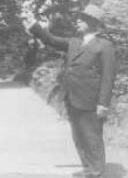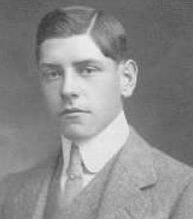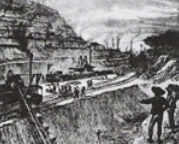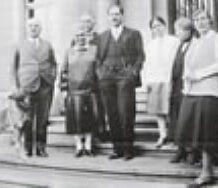On the trail of Panama Sonderegger
On a wet and cold April day in 1938 when Pizol and Falknis were shrouded in cloud, a long funeral procession wound its way through the spa town. Bad Ragaz was in the process of paying its last respects and giving a dignified send off to its honorary citizen, Conrad Sonderegger, better known locally as Panama Sonderegger: at the head of the
procession the music society played Frédéric Chopin’s funeral march, behind them followed the flower decked coffin, then came the flags of all the local clubs and societies followed by the measured steps of members of the town council and administration, the school council, the Church leaders, delegations from trade, industry and tourism and finally
a large number of ordinary mourners. The bells from both churches rang out as the deceased was once again honoured in front of Gasthaus Weisses Kreuz.
Finally the hearse drove to Zürich, where the funeral took place at the Manegge Cemetery. Editor Fritz Lendi, wrote in the Freien Oberländer newspaper: Conrad Sonderegger has left us for ever. He will, however, live on in the hearts of the people of Ragaz. There are many who will never forget him and remember him with respect and gratitude their whole life long.
More than half a century has passed and even the great Panama Sonderegger has all but been forgotten. His castle, which he had built
as a grand summer residence, still stands and lives on as the successful Hotel Schloss Ragaz. Indeed, flags belonging to some of the clubs and
societies which Conrad Sonderegger founded in his time are still fluttering in the wind but memories of the celebrated personality have
faded and are only kept alive by some of the older inhabitants. Panama Sonderegger became a legend as a rich old chap who made his fortune from
the building of the Panama Canal and who spent his summers in his castle in Bad Ragaz. People fantasized as to how Sonderegger had come by
his legendary wealth and from these fantasies stem many adventure stories:
When during the 1880’s the Panama canal was built and so many workers were bitten by snakes and died, the story goes that someone from Ragaz,
by the name of Sonderegger, was involved. He was an engineer by profession and it is said that he collected the pay owed to the dead
workers. When word of this came out he had to flee. He smuggled the money out in an oil barrel and built two villas, one in Zurich and one
in front of Hof Ragaz. (Alois Senti, in: “Anekdoten, Schwänke und Witze aus dem Sarganserland” (Anecdotes, Stories and Jokes from Sarganserland)
Conrad Sonderegger was born on 12th July 1858 in Heiden, Canton Appenzell Ausserrhoden, son of Conrad Sonderegger and Katharina, née Hohl.
Together with a lively band of brothers and sisters he spent his early years in the high-lying village attending school there. He then trained
as an engineer at technical colleges in Munich and Berlin. Following in the footsteps of the greatest Swiss pioneers abroad, the
action hungry engineer wound up in Panama, where he obtained a managerial post on the building of the canal. At the beginning of the
1880s a French company had started to realise Engineer Ferdinand de Lesseps (builder of the Suez Canal)’s project.
Conrad Sonderegger was one of the managing engineers who had thousands of workers under him. In the mosquito-infested, back breaking
climate the death rate amongst the workers was extremely high. The French company failed in the face of the huge climatic and geographic
difficulties which stood in the way of conquering the isthmus of Panama. The canal was eventually completed by Americans.
Engineer Sonderegger, who in 1889 after the French pulled out of the building of the canal, had returned home, wrote a book, in French, about
his experiences and in particular his activities in Panama entitled “ Lâ Achèvement du Canal de Panama”. Alongside the technical
explanations, which are still of interest to engineers today, the portrayal of the disagreeable climatic conditions which made the
building of the canal so gruelling made a particular impact.
Conrad Sonderegger returned a made man. Two years previously, in 1887, he had married Maria Agrippina Zuluaga from the affluent family of
Juan de Dios von Ypijapa from Ecuador. And as Sonderegger was also lucky and successful in investing his fortune, on his return to his
homeland he declared assets of millions.
The Sonderegger-Zuluaga union bore four children. The eldest son, Conrad, an engineer, died after a long illness at the age of 48, just
two years after the death of his mother Agrippina. Conrad was born during a stopover in Paris, while daughter Ina was born in the hometown
of Heiden. Incidentally, Ina became the wife of the famous Swiss physicist Paul Scherrer. Mercedes, the youngest child died at the age of
just 20 and the youngest son, Fritz Bertrand, also an engineer, lived and worked for many years in Ticino.
An active homecoming
Back in Heiden, the active and industrious Sonderegger immediately found an interesting occupation. He was voted onto the Ausserrhode
cantonal council as early as 1890. As an experienced engineer he worked mainly for the planning and road committees. His interest in farming
questions manifested itself in the erection of a model plant along the lines of the American farming system with a U-shaped “Stall” (building
for livestock), on the property Zur Tanne bei Wald, which locally is still known today as the “Panama Stall”.
After a few years, Sonderegger sold the property. It was too cramped for him in Appenzellerland, and to the disappointment of his Häädener
fellow citizens he changed his place of residence to Zürich, where he devoted himself to studies of physics and research. Conrad Sonderegger
was, in his time, a well-known personality in technical and financial circles, possessing natural authority and vast knowledge.
Summers in Bad Ragaz
Conrad Sonderegger most likely became familiar with Ragaz during a holiday or spa visit and valued the peace and beauty of the place. In
any case, in 1890 he had already bought a shady property just outside the village and built a castle there as a stately summer residence.
Family Sonderegger spent the winters in Zürich and summers in Bad Ragaz. However, when the elderly gentleman began to be afflicted by old age,
the Sondereggers spent all year in the spa town.
Conrad Sonderegger was welcomed in Ragaz and well respected. He was interested in local events and put his knowledge and experience at the
disposal of everyone. He paid his taxes which meant that the then farming area received a considerable tax income. Conrad Sonderegger was
interested and generous when it came to financing improvements. Charitable organisations valued his name at the top of a list of donors
as an incentive to others to donate, and poor fellows seldom knocked in vain on the castle door. The bestowal of honorary citizenship was the
well-earned recognition of Conrad Sonderegger’s charitable deeds in Bad Ragaz.
Ragazer Reminiscences
One of Sonderegger’s grandchildren, Ines Scherrer, often stayed with her grandparents in Ragaz in the holidays. Ines, long ago Frau Dr.
Jucker-Scherrer, still dreams of the lovely times in Bad Ragaz: He was a wonderful grandfather, good-natured, entertaining and above all
solicitous. When one played in the park, he stood on his balcony and watched through his binoculars and when one walked through the
countryside he explained everything with great patience. Grandfather also always thought I was too fat. Nevertheless, whenever we went to
Chur on a shopping spree, we always ended up in the best cake shop. That’s how strict good grandfather’s are!
Current:
Ownership
After more than 60 years of ownership, the hotel was sold to the Kasper Immobilien Group based in Aargau by the Touring Club Schweiz (TCS) at the end of 2019. Hotel Schloss Ragaz GmbH was foundet on January the 1st 2020 and was converted into Hotel Schloss Ragaz AG on January the 1st in 2021. One of the co-owner of the hotel is Mister Patrick Zettel (Director).






